
Technical information
- Operating conditions:
- Temperature 5 °C to 40 °C (41 °F to 104 °F)
- Relative humidity 15 to 90 % (non-condensing)
- Pressure 700–1060 hPa (<3000 m/9842 ft. altitude)
- Storage and transportation conditions:
- Temperature -25 °C to 70 °C (-13 °F to 158 °F)
- Relative humidity up to 90 % (non-condensing)
- Materials: polypropylene, silicone
- Service life: 500,000 pump cycles
Troubleshooting
This chapter summarizes the most common problems you could encounter
with the manual breast pump. If you are unable to solve the problem with the
information below, visit www.philips.com/support for a list of frequently
asked questions or contact the Consumer Care Center in your country.
Problem Solution
I experience pain
when I use the breast
pump.
- Make sure that your nipple is placed in the
center of the cushion.
- Press the handle down to a vacuum level that
is comfortable for you.
- If the pain persists, stop using the breast pump
and consult your healthcare professional.
I do not feel any
suction.
- Make sure you have assembled the breast pump
correctly (see 'Assembling the breast pump').
- Make sure that the breast pump is positioned
correctly on the breast to allow a seal between
breast pump and breast.
The breast pump is
damaged.
In case of regular use, some light scratching is
normal and does not cause problems. However,
if a part of the breast pump is badly scratched
or cracked, stop using the breast pump and
contact the Philips Consumer Care Center or
visit www.philips.com/support to obtain a
replacement part.
Undesirable side eects
When using the breast pump, the below undesirable side eects may occur.
If you experience any of these symptoms, contact a healthcare professional
or breastfeeding specialist.
Undesirable
side eect
Description
Pain sensation Pain felt on the breast or nipple, or felt as a response
to the suction being above a comfortable level.
Sore nipples Persistent pain in the nipples at the beginning of the
pumping session, or that lasts throughout the entire
pumping session, or pain between sessions.
Erythema
(redness)
Redness of the skin of the breast.
Bruise A reddish-purple discoloration that does not fade
when pressed. When a bruise fades, it may become
green and brown.
Thrombus Thrombus can result into tenderness, pain, redness,
swelling and/or heat.
Injured tissue on
nipple (nipple
trauma)
- Fissures or cracked nipples.
- Skin tissue peeling o the nipple. Normally occurs
in combination with cracked nipples and/or
blisters.
- Nipple tear.
- Blister. Looks like small bubbles on the surface of
the skin.
- Bleeding. Cracked or torn nipples can lead to
bleeding of the aected area.
Explanation of symbols
The warning signs and symbols are essential to ensure that you use this
product safely and correctly and to protect you and others from injury.
This symbol indicates:
- to follow the instructions for use (Fig. 14).
- important information such as warnings and cautions (Fig. 15).
- usage tips, additional information or a note (Fig. 16).
- the manufacturer (Fig. 17).
- the manufacturing date (Fig. 18).
- the manufacturer‘s catalog number of the breast pump (Fig. 19).
- the batch number of the medical device (Fig. 20).
- Forest Stewardship Council (Fig. 21).
- that an object is capable of being recycled – not that the object has been
recycled or will be accepted in all recycling collection systems (Fig. 22).
- that the material used in the product is safe for food contact (Fig. 23).
3 Push the stem into the silicone diaphragm to the end (Fig. 5).
4 Insert the silicone diaphragm into the pump body from above. Make sure
it ts securely around the rim by pressing down with your ngers to
ensure a perfect seal (Fig. 6).
5 Attach the handle onto the diaphragm with stem by hooking the hole in
the handle over the end of the stem. Push down the handle onto the
pump body until it clicks into place (Fig. 7).
6 Place the cushion into the pump body (Fig. 8) and make sure that the
rim covers the pump body. Push the inner part of the cushion into the
funnel. Make sure that you push the cushion inwards completely, up to
the line indicated with an arrow on the pump body (Fig. 9).
Note: Place the cushion cover (SCF430/10, SCF430/13) over the cushion
to keep the breast pump clean while you prepare for expressing.
Using the breast pump
Warning: Always use the breast pump with the cushion.
Note: Contact your healthcare professional in case of questions or if
you experience side eects.
Operating the breast pump
1
Wash your hands thoroughly with soap and water and make sure that
your breast is clean.
2 Press the assembled pump body against your breast. Make sure that
your nipple is centered, so that the cushion creates an airtight seal.
3 Gently start to press down the handle until you feel the suction on your
breast (Fig. 10). Then allow the handle to return to its resting position.
Repeat this step rapidly 5 or 6 times to initiate the ‘let-down’ reex.
Note: You do not have to press down the handle fully. Press it down
as much as is comfortable for you. Your milk will soon start owing, even
though you are not using all the suction the pump can generate.
4 When the milk starts owing, adopt a slower rhythm by pressing down
the handle and keeping it pressed down for a moment before you let it
return to its resting position. Continue with this rhythm while your milk is
owing. If your hand becomes tired, try to use the other hand or pump
from the other breast.
Note: Do not worry if your milk does not ow immediately. Relax and
continue pumping. Repositioning the breast pump on your breast from
time to time can help stimulate milk ow.
5 Continue pumping until you feel your breast is empty.
6 When you have nished expressing, carefully remove the breast pump
from your breast and unscrew the bottle or storage cup from the pump
body. Clean the other used parts of the breast pump (see ‚Cleaning and
disinfecting‘).
After use
Warning: Only store breast milk collected with a clean and
disinfected pump.
If you intend to feed your baby with the expressed breast milk within
4 days, you can store the breast milk in the refrigerator in an assembled
Philips Avent bottle or storage cup. Otherwise, you can store breast milk in
the freezer for up to 6 months.
1 To store the breast milk: close the bottle with the sealing disc and screw
ring (Fig. 11).
2 To prepare the bottle for feeding your baby: place a teat in a screw ring
and screw the assembled screw ring onto the bottle. Seal the teat with
the bottle cap (Fig. 12).
3 In case a storage cup is included with the manual breast pump, screw
the lid onto the storage cup. Make sure you properly close it to avoid
leakage (Fig. 13).
4 Disassemble and clean all parts that have been in contact with breast
milk (see ‚Cleaning and disinfecting‘).
Note: For safe use of bottles and storage cups, please read the
separately provided user manuals.
Warning: Refrigerate or freeze expressed milk immediately, label
with date and time, or keep it at a room temperature for a maximum
of 4 hours before you feed your baby. Never refreeze thawed breast
milk to avoid a decrease in milk quality. Never add fresh breast milk
to frozen breast milk to avoid a decrease in milk quality and
unintended thawing of the frozen milk.
Note: For more information about the breast pump and tips for
expressing milk, visit www.philips.com/avent.
Storage
Keep the breast pump out of direct sunlight as prolonged exposure may
cause discoloration. Store the breast pump and its accessories in a safe,
clean and dry place.
Compatibility
The Philips Avent manual breast pump is compatible with all baby bottles in
the Philips Avent Natural range and Philips Avent storage cups with an
adapter for cup. We do not recommend using the Philips Avent Natural
glass bottles with the breast pump.

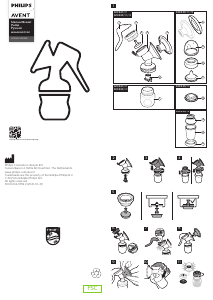


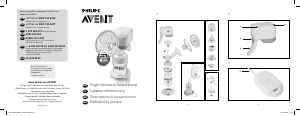
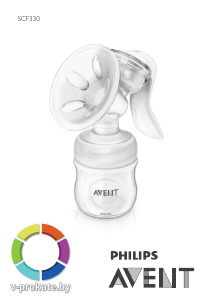
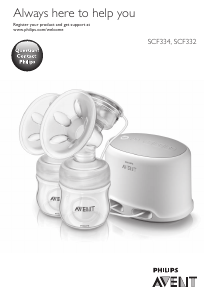

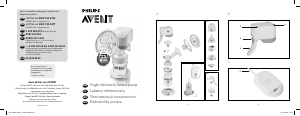
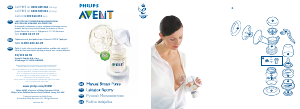
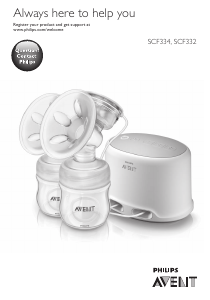
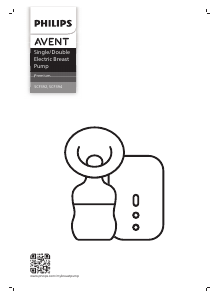
Присоединиться к беседе по данному изделию
Здесь вы можете поделиться тем, что думаете о Philips SCF430 Avent Молокоотсос. Если у вас есть вопросы, сначала внимательно прочтите инструкцию. Запросить руководство можно с помощью контактной формы.